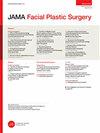Association of Perioperative Opioid-Sparing Multimodal Analgesia With Narcotic Use and Pain Control After Head and Neck Free Flap Reconstruction.
Q1 Medicine
引用次数: 29
Abstract
Importance An increase in narcotic prescription patterns has contributed to the current opioid epidemic in the United States. Opioid-sparing perioperative analgesia represents a means of mitigating the risk of opioid dependence while providing superior perioperative analgesia. Objective To assess whether multimodal analgesia (MMA) is associated with reduced narcotic use and improved pain control compared with traditional narcotic-based analgesics at discharge and in the immediate postoperative period after free flap reconstructive surgery. Design, Setting, and Participants This retrospective cohort study assessed a consecutive sample of 65 patients (28 MMA, 37 controls) undergoing free flap reconstruction of a through-and-through mucosal defect within the head and neck region at a tertiary academic referral center from June 1, 2017, to November 30, 2018. Patients and physicians were not blinded to the patients' analgesic regimen. Patients' clinical courses were followed up for 30 days postoperatively. Interventions Patients were administered a preoperative, intraoperative, and postoperative analgesia regimen consisting of scheduled and as-needed neuromodulating and anti-inflammatory medications, with narcotic medications reserved for refractory cases. Control patients were administered traditional narcotic-based analgesics as needed. Main Outcomes and Measures Narcotic doses administered during the perioperative period and at discharge were converted to morphine-equivalent doses (MEDs) for comparison. Postoperative Defense and Veterans Pain Rating Scale pain scores (ranging from 0 [no pain] to 10 [worst pain imaginable]) were collected for the first 72 hours postoperatively as a patient-reported means of analyzing effectiveness of analgesia. Results A total of 28 patients (mean [SD] age, 64.1 [12.3] years; 17 [61%] male) were included in the MMA group and 37 (mean [SD] age, 65.0 [11.0] years; 22 [59%] male) in the control group. The number of MEDs administered postoperatively was 10.0 (interquartile range [IQR], 2.7-23.1) in the MMA cohort and 89.6 (IQR, 60.0-104.5) in the control cohort (P < .001). Mean (SD) Defense and Veterans Pain Rating Scale pain scores postoperatively were 2.05 (1.41) in the MMA cohort and 3.66 (1.99) in the control cohort (P = .001). Median number of MEDs prescribed at discharge were 0 (IQR, 0-18.8) in the MMA cohort and 300.0 (IQR, 262.5-412.5) in the control cohort (P < .001). Conclusions and Relevance The findings suggest that after free flap reconstruction, MMA is associated with reduced narcotic use at discharge and in the immediate postoperative period and with superior analgesia as measured by patient-reported pain scores. Patients receiving MMA achieved improved pain control, and the number of narcotic prescriptions in circulation were reduced. Level of Evidence 3.头颈部游离皮瓣重建术后围术期阿片类镇痛与麻醉药品使用和疼痛控制的关系。
麻醉药品处方模式的增加导致了当前美国阿片类药物的流行。保留阿片类药物的围手术期镇痛是一种在提供卓越围手术期止痛的同时降低阿片类依赖风险的方法。目的评估与传统的麻醉镇痛药相比,多模式镇痛(MMA)在游离皮瓣重建术后出院时和术后即刻是否与减少麻醉剂使用和改善疼痛控制有关。设计、设置和参与者这项回顾性队列研究评估了2017年6月1日至2018年11月30日在三级学术转诊中心接受头颈部贯穿粘膜缺损自由皮瓣重建的65名患者(28名MMA,37名对照)的连续样本。患者和医生并没有对患者的镇痛方案视而不见。术后随访30天。干预措施患者接受术前、术中和术后镇痛方案,包括预定和必要的神经调节和抗炎药物,麻醉药物保留用于难治性病例。对照组患者根据需要服用传统的麻醉性镇痛药。主要结果和测量将围手术期和出院时的麻醉剂量转换为吗啡当量(MED)进行比较。术后前72小时收集术后防御和退伍军人疼痛评分量表疼痛评分(范围从0[无疼痛]到10[可想象的最严重疼痛]),作为患者报告的镇痛有效性分析方法。结果MMA组共有28例患者(平均[SD]年龄64.1[12.3]岁;男性17例[61%]),对照组共有37例(平均[SB]年龄65.0[11.0]岁;女性22例[59%])。MMA队列术后MED给药次数为10.0(四分位间距[IQR],2.7-23.1),对照组为89.6(IQR,60.0-104.5)(P < .001)。MMA组的平均(SD)防御和退伍军人疼痛评定量表术后疼痛评分为2.05(1.41),对照组为3.66(1.99)(P = .001)。MMA队列中出院时开具的MED中位数为0(IQR,0-18.8),对照队列为300.0(IQR:262.5-412.5)(P < .001)。结论和相关性研究结果表明,在游离皮瓣重建后,MMA与出院时和术后立即减少麻醉药物使用有关,并通过患者报告的疼痛评分来衡量其镇痛效果。接受MMA治疗的患者疼痛控制得到改善,流通中的麻醉处方数量减少。证据级别3。
本文章由计算机程序翻译,如有差异,请以英文原文为准。
求助全文
约1分钟内获得全文
求助全文
来源期刊

JAMA facial plastic surgery
SURGERY-
CiteScore
4.10
自引率
0.00%
发文量
0
期刊介绍:
Facial Plastic Surgery & Aesthetic Medicine (Formerly, JAMA Facial Plastic Surgery) is a multispecialty journal with a key mission to provide physicians and providers with the most accurate and innovative information in the discipline of facial plastic (reconstructive and cosmetic) interventions.
 求助内容:
求助内容: 应助结果提醒方式:
应助结果提醒方式:


